
There is hardly anyone in the country today – a consummate media observer, who is not denying the existence of professional ethics, integrity and honesty in main stream media. For a good chunk of end users – the consumers, there exists suspicion beyond doubt that what they are being served as news is largely propaganda and more of stenography that borders dictation and worse.
For the professional field hailed as the fourth pillar of democracy, nothing could be a more sorry commentary than the allegation that it has been sold out.
In the good old times, not so long past, media was revered and respected for its intellectual hold, for the sincerity with which the news anchors presented themselves and the news. It had the reputation of being looked upon as the post master of last resort delivering to those concerned at the helm of affairs, the voice of the margins through a committed fleet of ground reporters. Those good days ironically were from the times when India had just one news channel and that too under government control.
In their critical analysis most observers apportion the blame for media’s gradual decay to the rise of the far right and the consequent impregnation of the ideology in the news room. Without going into the merits of the claim which might be true to a large extent, media acquiring its workforce from the same society it reports to, one must explore what other forces have been at play that have made media cow down. The bowing down of media to powers that be is certainly not a recent phenomenon and the rise of the far right in that sense is a reason far too stretched.
The opening of the economy after a graded liberalization phase and systemic adjustments across sectors has often found itself under intellectual and academic lens. But, the trajectory of discourse it charts out has been largely restricted to the paradox of material well-being and the rise in inequality. Less has been discussed about the impact of market forces on non-commercial traditional sectors such as Media.
Media post liberalization was sworn to the business “mool mantra” (basic tenet) of wealth or value maximization, like it’s contemporaries from other sectors. Acquiring and retaining capital was thus a natural corollary. The transition to a more adaptable technology, and the loosening up of investment rules crowded the field with several ventures, quite a few of which were financed from same sources through strings of business dealings routed through a chain of foreign investors. This perhaps was the first step towards a blatant monopolization that we see today.
The cut throat competition and the compulsions of bottom-line that ensued crippled its capacity by way of logistics and quality resources. To perform yet, increasingly came at a price of content. The bar of credibility as the metrics of performance was replaced with the trendier TRP. To keep the baton of TRP rising the anchors were glamorized, their sincere tone amplified, and their deep voice made pitch sharp. The reporting fleet got thinner and thinner, and the cult of the star anchor was built as a substitute. But, for all the fancy window dressing, the content that should have been went from bad to worse. For a better part in the first decade of the twenty first century the viewers were doomed to view fantasy and mythology as prominently featured news on majority of news channels. The period was also marked by the first of the many wars the millennia was to see – battleground Afghanistan and later Iraq. It was while presenting the subject in quest of increased viewership the stereotype of Muslim as terrorist was born. It’s also pertinent to note that the very word terrorist found very little to less currency every time it was used before. In fact, it remains in public memory that Bhagat Singh the revolutionary leader was called a terrorist by the imperial powers.
Incidents like 9/11, America’s war on terror, parliament and Akshardham attack, the Godhra train burning and the and the consequent Gujarat riots brought with them a ready-mix formula for harvesting TRP’s. As a result, every channel got busy killing the state’s enemies in animated videos or as per reliable sources, as went their claim. Life got hell for the Ladens and Mullah Umars who were to die in studios if not in the battlefield. Ordinary Muslims in any case were to pay the price with their caricature occupying every visual dramatization. Amid so much of happening within and outside the country, with the capacity to rouse passions and swell the broadcaster’s coffers, the Media houses went shopping for security experts. The age of field reporters was already on the decline and they were conveniently replaced with retired military personnel to do the talking, or less of it perhaps, and more of sabre rattling. The millennial viewers were left to fend for themselves were they in quest for authentic stories. As for the elders at home the TV remained an idiot box to be looked upon with skepticism and locked away from reach of children if possible. It’s also worth noting that the said degeneration was happening at a time when the proposition of the dominance of the far right was worth no sincerity in intellectual circles. This brings us back to the point that the media’s fall was not alone a result of its waning neutrality, and the compulsions of exceeding ROI had a far bigger role to play.
Every trade must seek a willing partner. The content that is being circulated today in main stream media would be worth nothing if it wasn’t tailored to suit viewers tastes and preferences. Since the start of its degeneration, both the media and its users have come a long way. The elderly at home have become new converts giving up their skepticism to words of praise. The grown-ups even with their exposure to the world outside have limited themselves to believing the fake and the illogical. Near two decades of subscription to filth has led them to become contributors of hate and propaganda, reinforcing what the channels originally set out to do.
Intriguing, hence it is not, that the flourishing trade was to find the eyes of big merchants and fancy of the political class. Still, it is much after people had shelved rationality, the role of the far right starts. And it’s only just the beginning. One wonders how much more they could push us to the life and times of unreason.
Md. Aariz Imam is a Jamia Millia Islamia alumni, freelancing for citizen journalism portals reflecting upon the old and contemporary from the sub altern’s point of view .
















































